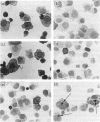Abstract
After T-cell activation, a switch of leucocyte common antigen (LCA) expression occurs which is detected by the disappearance of CD45R and the appearance of UCHL1 positivity. Upon activation of CD45R+ T cells by phytohaemagglutinin (PHA), the IL-2 receptor (IL-2R) develops at 15 hr and blast cells enter the S phase at 20 hr, while remaining UCHL1-. At 40 hr, mitotic cells continue to express CD45R determinants, but weak UCHL1 reactivity is now detectable on 15-20% of these cells. By inhibiting the separation of daughter cells with cytochalasin B, it can be demonstrated that the UCHL1 antigen is newly synthesized in the Golgi apparatus before insertion into the membrane after the first mitosis. At 65 hr after activation, 80% of proliferating cells are UCHL1+. T cells undergo a similar development during allogeneic activation, and specific alloresponsive cells, tested in secondary mixed lymphocyte reaction (MLR), become greatly enriched among the proliferating UCHL1+ cells. Conversely, after a primary MLR, residual CD45R+ T cells are unresponsive to the original stimulus but can still proliferate in response to unrelated alloantigens. These results clarify both the time-course of the acquisition of UCHL1 antigen during the proliferative cycle of activated T cells, and indicate the shift of antigen responsive T-cell populations from the CD45R+ to the UCHL1+ pool.
Full text
PDF





Images in this article
Selected References
These references are in PubMed. This may not be the complete list of references from this article.
- Akbar A. N., Jones D. B., Wright D. H. Spontaneous and Concanavalin A-induced suppressor activity in control and Hodgkin's disease patients. Br J Cancer. 1984 Mar;49(3):349–356. doi: 10.1038/bjc.1984.55. [DOI] [PMC free article] [PubMed] [Google Scholar]
- Akbar A. N., Terry L., Timms A., Beverley P. C., Janossy G. Loss of CD45R and gain of UCHL1 reactivity is a feature of primed T cells. J Immunol. 1988 Apr 1;140(7):2171–2178. [PubMed] [Google Scholar]
- Cantrell D. A., Smith K. A. Transient expression of interleukin 2 receptors. Consequences for T cell growth. J Exp Med. 1983 Dec 1;158(6):1895–1911. doi: 10.1084/jem.158.6.1895. [DOI] [PMC free article] [PubMed] [Google Scholar]
- Damle N. K., Childs A. L., Doyle L. V. Immunoregulatory T lymphocytes in man. Soluble antigen-specific suppressor-inducer T lymphocytes are derived from the CD4+CD45R-p80+ subpopulation. J Immunol. 1987 Sep 1;139(5):1501–1508. [PubMed] [Google Scholar]
- Gerdes J., Lemke H., Baisch H., Wacker H. H., Schwab U., Stein H. Cell cycle analysis of a cell proliferation-associated human nuclear antigen defined by the monoclonal antibody Ki-67. J Immunol. 1984 Oct;133(4):1710–1715. [PubMed] [Google Scholar]
- Gullberg M., Smith K. A. Regulation of T cell autocrine growth. T4+ cells become refractory to interleukin 2. J Exp Med. 1986 Feb 1;163(2):270–284. doi: 10.1084/jem.163.2.270. [DOI] [PMC free article] [PubMed] [Google Scholar]
- Ledbetter J. A., Rose L. M., Spooner C. E., Beatty P. G., Martin P. J., Clark E. A. Antibodies to common leukocyte antigen p220 influence human T cell proliferation by modifying IL 2 receptor expression. J Immunol. 1985 Sep;135(3):1819–1825. [PubMed] [Google Scholar]
- Lefrançois L., Bevan M. J. Functional modifications of cytotoxic T-lymphocyte T200 glycoprotein recognized by monoclonal antibodies. Nature. 1985 Apr 4;314(6010):449–452. doi: 10.1038/314449a0. [DOI] [PubMed] [Google Scholar]
- Morimoto C., Letvin N. L., Rudd C. E., Hagan M., Takeuchi T., Schlossman S. F. The role of the 2H4 molecule in the generation of suppressor function in Con A-activated T cells. J Immunol. 1986 Nov 15;137(10):3247–3253. [PubMed] [Google Scholar]
- Munro C. S., Campbell D. A., Du Bois R. M., Mitchell D. N., Cole P. J., Poulter L. W. Suppression associated lymphocyte markers in lesions of sarcoidosis. Thorax. 1988 Jun;43(6):471–474. doi: 10.1136/thx.43.6.471. [DOI] [PMC free article] [PubMed] [Google Scholar]
- Ralph S. J., Thomas M. L., Morton C. C., Trowbridge I. S. Structural variants of human T200 glycoprotein (leukocyte-common antigen). EMBO J. 1987 May;6(5):1251–1257. doi: 10.1002/j.1460-2075.1987.tb02361.x. [DOI] [PMC free article] [PubMed] [Google Scholar]
- Sanders M. E., Makgoba M. W., Sharrow S. O., Stephany D., Springer T. A., Young H. A., Shaw S. Human memory T lymphocytes express increased levels of three cell adhesion molecules (LFA-3, CD2, and LFA-1) and three other molecules (UCHL1, CDw29, and Pgp-1) and have enhanced IFN-gamma production. J Immunol. 1988 Mar 1;140(5):1401–1407. [PubMed] [Google Scholar]
- Sanders M. E., Makgoba M. W., Shaw S. Human naive and memory T cells: reinterpretation of helper-inducer and suppressor-inducer subsets. Immunol Today. 1988 Jul-Aug;9(7-8):195–199. doi: 10.1016/0167-5699(88)91212-1. [DOI] [PubMed] [Google Scholar]
- Seaman W. E., Talal N., Herzenberg L. A., Herzenberg L. A., Ledbetter J. A. Surface antigens on mouse natural killer cells: use of monoclonal antibodies to inhibit or to enrich cytotoxic activity. J Immunol. 1981 Sep;127(3):982–986. [PubMed] [Google Scholar]
- Tedder T. F., Cooper M. D., Clement L. T. Human lymphocyte differentiation antigens HB-10 and HB-11. II. Differential production of B cell growth and differentiation factors by distinct helper T cell subpopulations. J Immunol. 1985 May;134(5):2989–2994. [PubMed] [Google Scholar]
- Terry L. A., Brown M. H., Beverley P. C. The monoclonal antibody, UCHL1, recognizes a 180,000 MW component of the human leucocyte-common antigen, CD45. Immunology. 1988 Jun;64(2):331–336. [PMC free article] [PubMed] [Google Scholar]



